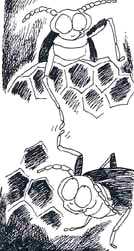Sticky relations
 WASPS from the same nest recognise each other by smearing wax from the outside of the nest onto themselves, discovered scientists at the University of Georgia in the US. If the wax is removed, nest-mates fail to recognise a member and drive it out.
WASPS from the same nest recognise each other by smearing wax from the outside of the nest onto themselves, discovered scientists at the University of Georgia in the US. If the wax is removed, nest-mates fail to recognise a member and drive it out.
Poliste wasps (Polistes metricus) coat their nests with a mixture of more than 20 waxes contributed by all the colony members. The mixture can form upto four per cent of the nests' dry weight. The same mixture adheres to the hard cuticle of each member, while each of them also has a slightly different personal wax composition. Colony members respond sensitively to these differences.
The ability to recognise siblings from unrelated members of another colony is of particular importance to these social insects. Entomologists find newly emerged colony members distinguish nest-mates only after being exposed to their home nest.
Using this as the basis, scientists Theresa Singer and Karl Espelie tested whether wax from nest surfaces helped wasps recognise their siblings. Their findings seem to reveal that young wasps smear themselves with the nest wax rather than wax from each other's cuticles, becoming familiar first with their colony's homogeneous "wax bank", and later, with the slightly different individual variations.
